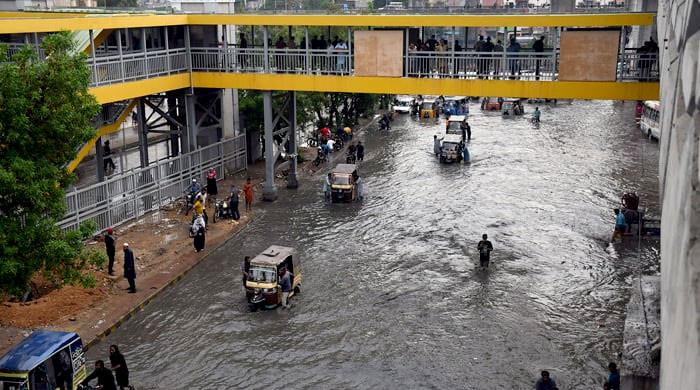Monsoon Rains Disrupt Karachi for Third Day
Continuous monsoon rains have impacted Karachi for the third consecutive day, resulting in water accumulation in several low-lying areas and disrupting daily life.
Moderate to heavy rainfall was reported in areas including II Chundrigar Road, Saddar, Lyari, Gulistan-e-Jauhar, Gulshan-e-Iqbal, DHA, Clifton, Tariq Road, and North Nazimabad.
According to data from the Pakistan Meteorological Department (PMD), Gulshan-e-Maymar experienced the highest rainfall at 23mm, followed by Surjani Town at 22mm, Saadi Town at 17mm, University Road at 11mm, Nazimabad at 8.2mm, and Jinnah Terminal at 6mm.
Following the rainfall, numerous localities in Karachi faced waterlogging, prompting questions regarding the Sindh government’s previously stated readiness for the monsoon season.
Karachi Mayor Murtaza Wahab conducted visits to several rain-affected regions on Saturday evening, which included Soldier Baazaar, Guru Mandir, Patel Para, and Jahangir Road. He urged citizens to exercise caution and avoid unnecessary travel during the intermittent rainfall.
The weather authorities have predicted light to moderate showers with the likelihood of heavy downpours in the city throughout Saturday. Current wind conditions show winds blowing from the northeast at 10 km/h, according to the weather department.
The weather department has also indicated intermittent rain for Karachi on Sunday, with the possibility of moderate to heavy rainfall in specific areas.
For Monday, the Met Office anticipates cloudy weather across the city with chances of light rain or drizzle.
Elsewhere in Sindh, the advisory indicates that thundershowers in Hyderabad, Dadu, Badin, Ghotki, Kashmore, Jacobabad, Tharparkar, Mirpurkhas, Umerkot, Khairpur, Sukkur, Larkana, Qambar Shadadkot, Shaheed Benazirabad, and adjacent areas are expected to persist until tomorrow, with intervals.
The Met Office further cautioned that heavy rainfall, windstorms, and lightning could potentially disrupt daily activities, cause urban flooding and waterlogging in low-lying areas, and inflict damage on vulnerable structures, such as roofs and walls of temporary houses, utility poles, billboards, vehicles, and solar panels during the forecast period.



Comments (0)
No comments yet. Be the first to comment!
Leave a Comment